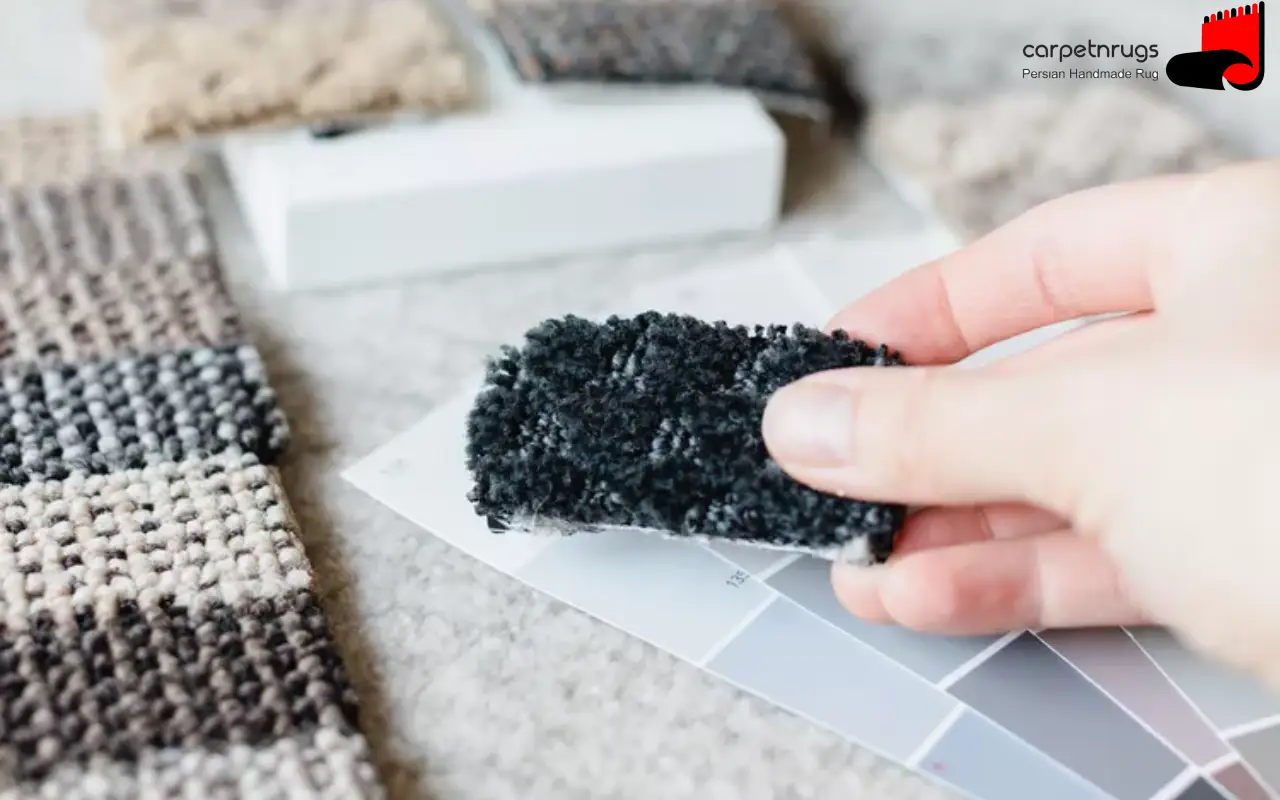
Special sale of carpet
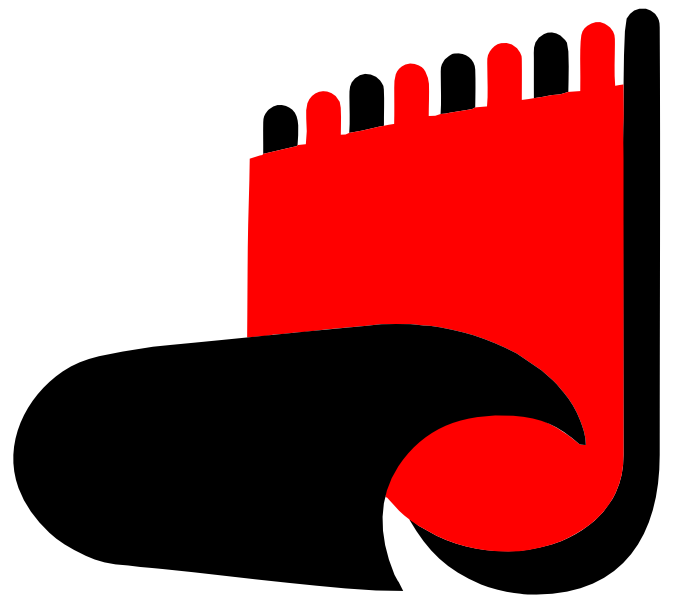
carpetnrugs
Persuan Handmade Rugs

The basis of the carpet begins with the chela. The material of the shawl is wool, cotton, silk or hair, and sometimes a combination of wool and cotton. This yarn has a lot of warp to withstand high tension.
It also has different thicknesses depending on the type of carpet. When weaving, the threads of the loom are pulled vertically and parallel to each other on the gallows.
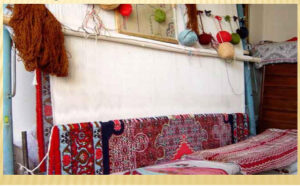
It is a thread made of wool, cotton, silk or hair, and sometimes a combination of wool and cotton, which is spun with low heat and has two types of thick and thin. Weft is mostly used in cream and white, red, black, blue, brown or self-dyed colors (the color of sheep or goat wool). The number of wefts, the type of tension i.e. loose, medium and firm, color, weave and type of weft play a key role in creating different types of carpet textures in each region.
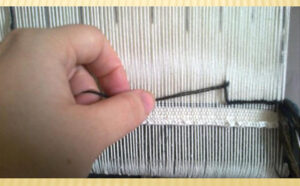
Twists of yarn are tied around the threads in a special order. Knotting and creating patterns by means of them is the basis of carpet weaving. The node has different types. Carpet weavers tie pile yarn on the threads in different ways, the most important types of knots are two types:
In this type of knot, the pile thread wraps around every two threads upside down and creates a symmetrical shape. This type of knot is also known as Azari (Turkish) knot. It is common in the west of the country and some tribes of Fars.
In this type of knot, the pile thread is wrapped around only one thread and creates an asymmetric shape. This type of knot is also known as Persian knot. In this type of knot, the pile thread wraps around one of the threads, so it creates an asymmetric shape. This knot is common among the weavers of Khorasan, Qom, Arak, Isfahan, Kerman and other regions.
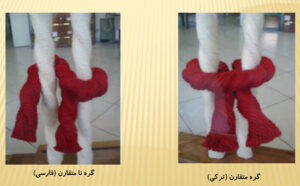
Farsi Baf regions: Isfahan – Nain – Kashan – Qom – Arak – Hamadan – Yazd – Kerman – Mashhad
Turkish weaving areas: Tabriz – Ardabil – Haris – Middle – Marand – Khoi – Bijar – Maragheh – Shabstar
A tube-shaped texture or a wide strip that is located on both sides and along the length of the carpet and is considered as a carpet frame along with the carpet weave. Shiraz is one of the carpet’s durability factors because it makes the side piles stronger.
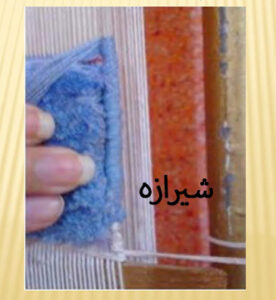
Every buyer should be aware of all the characteristics of the goods he buys. Nowadays, the specifications and materials used in each product along with the price and production date can be seen on the label. Carpet, like other products, has specifications and standards that must be clear for buyers and sellers. The specifications and features of all the carpets produced in each workshop must be attached by a professional assessor with a label on the corner and back of the carpet, which is called the carpet certificate. The certificate of registration of the carpet shows the characteristics of the carpet in the following cases: price, area of production, dimensions, color, approximate number of knots per meter, exporter’s name, carpet design, country of manufacture, type of carpet, age (old, salted, new).
| Birth certificate and technical specifications |
| Carpet dimensions: | Density or approximate number of knots per square meter: |
| Number of colors: | Producing country: |
| Type of fiber (knot, weft, skein) | Name of the issuer: |
| Name of designer: | Age (old – old salty – new): |
| Design name: | Color type (vegetable-chemical): |
| Production area: | Node type: |
| Order number: | Price: |
| Types of colors: |
In general, carpets are divided into two categories in terms of shape:
As you know, the counting unit of the carpet is the board. On the other hand, the carpets are called by a special term based on the size, so that you can get help from the above titles to check the variety of dimensions of the carpets. The sizes used today for carpet weaving are as follows:
Common dimensions in handwoven carpets
| Title | Dimensions and sizes | Unit of measurement |
| a priest | 40*60 | centimeter |
| the back
|
90*60
120*80
|
centimeter |
|
the vault
|
130*70
200*90 |
centimeter |
| Arms and quarters |
130*100
|
centimeter |
| Half a cubit | 156*104 | centimeter |
| A rug | 170*100 | centimeter |
| two cubits | 220*120
200*150 |
centimeter |
| curtain | 250*150 | centimeter |
| the side | Length 3 to 10
Width 70 to 120 |
centimeter |
| Middle | 300*150 | centimeter |
| Kalgi | 400*200 | centimeter |
| 6 meters | 3*2 | Meter |
| 9 meters | 3.5*2.5 | Meter |
| 12 meters | 4*3 | Meter |
| 24 meters | 4*6 | Meter |
| 40 meters | 5*8 | Meter |
It is a unit for measuring and measuring the density of the carpet fabric (density or number of carpet knots) in every 7 or 5.6 cm of length or width, it is called Rajeshmar. One of the common terms in handwoven carpets is the concept of Rajshmar. Along with several other factors such as the quality of the texture, the type of material used in the texture of the carpet, the carpet index can be considered one of the main factors that determine the price of an Iranian hand-woven carpet. Rajshmar is a unit for measuring the density of carpet texture, i.e. the density of carpet knots. Since the calculation of Iranian rug or carpet index is based on the unit of zarah, there are two measurement units to measure the density or index.
The higher the index, it means that the number of knots used in 7 or 5.6 cm is more and it indicates the fine texture of the carpet. Rajshmar also has a direct effect on the final price of the carpet, like the quality of the fabric and the type of material used in the carpet. Carpets are generally divided into three groups: coarse texture, semi-fine texture or medium texture, and fine texture.
Those with a index less than 30 are called coarse weave, carpets with an index between 30 and 5 are called medium and above 50 are called fine weave. Of course, there are carpets with a index higher than 70, which are exquisite and high quality carpets and are mostly woven to order.
It is one of the units of measurement of length in ancient times, which is considered to be equivalent to 112 current centimeters in Tabriz and 104 current centimeters in Isfahan. The carpet index is calculated in one sixteenth of an inch. With this calculation, the carpet index is calculated based on the Isfahan measure, every 5.6 centimeters, and based on the Tabriz measure, every 7 centimeters (length or width). Therefore, the Rajshmar based on 5.6 cm is called Farsi Baf and the Rajshmar based on 7 cm is called Turkish Baf.
The total number of carpet knots: the number of length knots * the number of width knots
Due to the fact that the carpet is handmade, there is a possibility of defects in it. Depending on the type or percentage of defects, due to the fact that it is handmade, some of its defects are ignored. But the defect must be such that it reduces its beauty or changes the original and harmonious shape of the carpet. Of course, in any case, it has an effect on pricing. Some of these defects are: Crooked, twisted, twisted, streaked, double-colored, silken, corned, bruised, baggy, lonely, torn, rotted, braided, twisted, etc.
